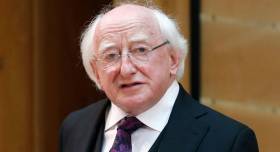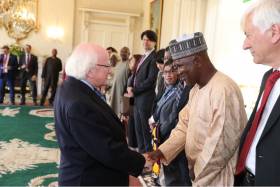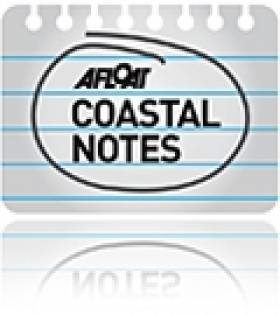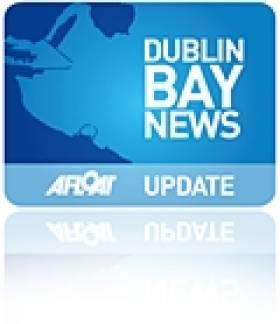Displaying items by tag: President Higgins
Criticised: President Higgins on Pay for Defence Forces
Ministers reports The Irish Examiner, have described comments by President Michael D Higgins that members of the Defence Forces should have sufficient incomes as “deeply unhelpful”.
Mr Higgins’s comments on Wednesday night caused widespread surprise, anger, and bemusement in Government circles yesterday over what was seen as “interference” in political matters.
As Fine Gael ministers, TDs, senators, and MEPs gathered in Garryvoe, east Cork, for their party’s think-in ahead of the Dáil’s return, Mr Higgins’s comments were widely commented upon.
“Of course they were deeply unhelpful,” one senior minister said. “We are trying to hold a public pay deal together with sticky tape and Blu-Tack. This will only heighten the pressure on us to loosen the purse strings even further.”
Speaking publicly, Agriculture Minister Michael Creed hit a most undiplomatic tone, saying he found the President’s decision to comment “quite unusual”.
The newspaper has more here on this ongoing issue.
#President&Ports - Senior port managers from developing countries who are passing on their expertise to colleagues met President Michael D. Higgins in Dublin, on 21 June during the week-long United Nations Conference on Trade & Development's Training of Trainers workshop.
President Higgins welcomed the managers from ports in Indonesia, Ghana, Malaysia, Nigeria, and the Philippines which are members of the English-speaking network of UNCTAD’s Train for Trade port management programme. Prospective members from Serbia and a former member from Namibia were also present.
"As an island nation, almost uniquely dependent on international trade, we in Ireland know and value the importance of our ports, and all who work there," Mr. Higgins said during a reception at Áras an Uachtaráin, his official residence.
The workshop was co-organized by Dublin Port Company, with the support of Port of Cork Company and Belfast Harbour Commissioners and held at the head office of Dublin Port Company and the National College of Ireland.
Prosperity for all
“I am so very proud that our ports here in Ireland and Irish Aid, our overseas development assistance programme, have been participating with the English-speaking network for eleven years now, and that they have agreed to continue for four more years,” Mr. Higgins said.
“It is an example of internationalization in the best sense, co-operative not competitive, dedicated to the prosperity of all the peoples of the world rather than a narrow few.”
The face-to-face workshop was the completion of a course that started with a distance learning component from April to June which represented a new blended learning strategy for the Port Management Programme.
The objective of the workshop was to prepare the senior port managers for their roles as future instructors in their port communities.
UNCTAD Secretary-General Mukhisa Kituyi was due to take part in the closing ceremonies of the workshop to distribute the certificates to successful candidates.
Golden Birthday for Dublin Bay Sentinel: Kish Lighthouse
#KishLight@50- The Commissioners of Irish Lights today welcomed the visit of President Michael D Higgins and Mrs. Sabina Higgins to join the Board and staff to say 'Happy Birthday' as the Kish Lighthouse celebrates 50 years of service on the 9th November 2015.
Imagine what that means.
How many millions of passengers have watched the Kish fade over the horizon as they emigrated to Britain and beyond? How many have watched its welcoming flash guide them safely back home to Ireland?
95% of everything we use arrives and leaves by sea. Imagine the cargoes made safe by the Kish Light. The agricultural products, the machinery, the building materials, the household goods, the cars, the clothes; every single staple of our lives has passed the great guiding lighthouse on the Kish.
As a witness to social history the Kish has seen significant change. Containerisation has changed the ships and crews, air travel has changed the passenger numbers, fuel costs have allowed it witness the growth and subsequent decline of fast vessels such as Jetfoil and HSS. (See, Afloat's latest report on the former Stena Explorer currently heading for Turkey).
Consider the lives of the Lighthouse Keepers who lived on the tower until automation in 1992.
The Kish Lighthouse is not just a seamark but a very significant engineering landmark of its day. The lighthouse replaced a lightship which was one of a series of such vessels that marked the Kish Bank since 1811 – meaning that there has been a continuous light on the Kish for the 204 years.
One Year On... Since Re-Opened National Maritime Museum
#OneYearOn – The National Maritime Museum of Ireland in Dun Laoghaire yesterday celebrated its first anniversary after last year's 'official' re-opening ceremony by President Michael D. Higgins following a €4m renovation, writes Jehan Ashmore.
Earlier this year the museum which is run by the Maritime Institute of Ireland were delighted to receive an award from the Industrial Heritage Association for 'Best Museum / Restored Site 2012'.
Among the most popular exhibits is the old optic of the Baily Lighthouse, Captain Halpin and the Great Eastern and the story of the RMS Leinster torpedoed on the Kish Bank. For more abou the exhibits visit the Video Virtual tour click HERE noting to click on map to begin. Better still make a visit to the museum in person!.. which is open 11am-5pm everyday until the end of July.
Currently on is display is the 'Bratacha Flags & Emblems Exhibition' which certainly adds a splash of colour with many nations represented amongst the museums existing shipping company house-flags that are draped around the contrasting dark timbered balcony.
Originally the building completed in 1836 was home to the Church of Ireland Mariners Church built of granite quarried from Dalkey that of course built the nearby harbour. The museums exhibits are surrounded by beautiful stained glass windows and the timber ceiling.
Such surroundings make a visit apt considering the building with its past to worshipping mariners is one of the last such structures left in the world.
The restored museum featured in a lavishly illustrated publication 'NEW LIFE for Churches in Ireland – Good Practice in Conversion and Reuse' which is available for sale in the museum's Gift Shop. Also stocked are a wide range of nautical-related merchandise including framed print scenes of the harbour, greeting cards and much more.
There's also a café serving hot snacks and where stain-glass windows which were also installed during the renovation plus a Wi-Fi hot-spot. Noting, the museum is mostly wheelchair accessible.
There are plans to reintroduce the library with its impressive range of historical books including the Lloyds Register of Shipping collection in the Lawlor Room, named after Col. Anthony Lawlor, the founder of the Maritime Institute of Ireland (M.I.I.) in 1941.
Another notable leading figure of the institute, was the late Dr. John de Courcy Ireland, who was widely regarded as the father of Maritime Ireland.
A group of volunteers from the institute as well as a team funded by the Community Employment Scheme of the Department of Social Protection provide staff duties that include guided group tours.
The museum welcomes new volunteers, so if can you assist in any way?... even if it's just a few hours a week call the museum on (01) 2800 969. For further information visit: www.mariner.ie
Mariners’ Church featured in New Life for Churches in Ireland
#MARINERS CHURCH – NEW LIFE for Churches in Ireland – Good Practice in Conversion and Reuse is the title of a new multi-authored publication. Among the diverse range of 17 case studies is the former Mariners' Church, Dun Laoghaire, which as the National Maritime Museum of Ireland was officially reopened in June by President Michael D. Higgins.
At the reopening President Higgins said "This magnificent old Mariners' Church is one of the few large mariner churches in the world. It is a beautiful building...it is great to raise awareness of our maritime heritage".
Writing about the former Church of Ireland place of worship, Peter Pearson details the history of the building erected in 1836 to the designs of Joseph Welland for the benefit of the many sailors who were based on Royal Navy vessels in the then new Kingstown Harbour.
Accompanying the case study are photographs including those taken by Jehan Ashmore on the day of the reopening to illustrate the building which underwent substantial conservation and renovation work (between 2005-2011) by James Slattery Architects.
Asides the Mariners' Church there are further case studies from throughout the island of Ireland, amongst them Elmwood Hall in Belfast, Carlingford Heritage Centre, Triskel Christ Church, Cork and St. Werburgh's Church, where last month the book had its Dublin launch.
Also featured are more modest but nevertheless important schemes, followed by a section featuring projects where work is underway but not complete. Schemes include the conversion of churches for domestic as well as cultural, commercial and community use. Each of these case studies are underpinned by an analysis of our ecclesiastical heritage, a flow chart to stimulate discussion on underused churches and an explanation of conservation principles and statutory responsibilities.
The 144-page publication is produced by the Ulster Historic Churches Trust and edited by Paul Harron. Among the other contributors are Edward McParland, Grainne Shaffrey, Patrick Shaffrey, Michael O'Boyle and Alistair Rowan. The book has a wealth of full colour photographs, drawings and illustrative material throughout.
Retail prices are €15 / £12 (softback) and €20 / £18 (hardback) and they can be purchased from the following stockists:
DUN LAOGHAIRE: Maritime Museum Gift Shop, National Maritime Museum of Ireland, Mariners'Church, Haigh Terrace (note: Open 11am-5pm Everyday)
DUBLIN: RIAI Bookshop / Irish Georgian Society (both on Merrion Square), Dublin Civic Trust, Castle St. (beside Dublin Castle) and St. Michan's Church office
BELFAST: Good Book Shop, Donegall St. (beside St Anne's Cathedral)
or available through Amazon.
ISBN: 978-0-9573791-1-4
#OLYMPIC TORCH RELAY – President Michael D.Higgins welcomed the London 2012 Olympics Torch Relay for the first time to Ireland in Howth Harbour, where the first torch-bearer Cillian Kirwin from St Fintan's High School in Sutton had the honour of running with the flame, reports Jehan Ashmore.
Kirwin, a 15 year-old cross country champion was greeted by the President. Also attending where Lord Sebastian Coe of the London Olympics, Sir Craig Reedie of the International Olympic Committee (IOC) representing Jacques Rogge, Pat Hickey President Olympic Council of Ireland (OCI) and Mayor of Fingal Cllr Gerry McGuire, aswell as Carál Ní Chuilín, Sports Minister of Northern Ireland who accompanied the relay.
Hundreds of locals, excited schoolchildren and visitors alike enjoyed the festive atmosphere at the fishing harbour where the Olympic Council of Ireland headquarters are based. Their premises formerly Howth House, built around 1807 was where the supervisor of Howth Harbour resided.
Today's historic event with its detour to the republic is part of a 70-day London torch relay tour in the UK. Earlier this morning the torch had crossed the border where it was passed between two former Olympic boxers, Belfast's Wayne McCullough and Dubliner Michael Carruth.
The President told the large crowd that the flame's arrival in Ireland symbolised the growing closeness of the relationship between the UK and Ireland. The President spoke of the Olympics "where sport builds bridges" and of friendship and fairplay.
After a brief ceremony the Olympic hymn was sung by local children from Scoil Mhuire Primary School as the flame was whisked away under Garda escort to Dublin. The torch tour included Croke Park, the Garden of Remembrance, GPO and Trinity College.
When the torch reached the Liffey, it was carried across the Samuel Beckett Bridge by former international soccer player Paul McGrath to the Grand Canal Theatre. At the same time Dublin Port Company tug sisters Shackleton and Beaufort paid a tribute by firing powerful water jets high into the sky.
The sporting spectacle drew large crowds along the bridge and office workers looked down from their quayside offices to witness the torch head for its final destination in St. Stephens' Green.
Irish team's Chef de Mission Sonia O'Sullivan became the final torch-bearer. The celebrations culminated when she performed lighting an Olympic cauldron to commemorate the visit.
Dublin Bay Ceremonies for OPV L.E. Roisin
#COMMAND CHANGEOVER CEREMONY– The offshore patrol vessel OPV L.E. Róisín (P51) arrived to Dun Laoghaire Harbour today for the official reopening of the town's maritime museum and follows a changeover command ceremony held on board the vessel in Dublin Port last Friday, writes Jehan Ashmore.
At the ceremony the Lord Mayor of Dublin, Cllr Andrew Montague along with the Flag Officer Commanding the Naval Service, Commodore Mark Mellett presided over the command handover along Sir John Rogersons Quay.
This saw Lieutenant Commander Terry Ward, who is originally from Dublin, take over command from Lieutenant Commander Peter Twomey of the OPV which was adopted by the City of Dublin in 2000 and has maintained a strong connection with the capital.
The OPV departed on Sunday on a short patrol in the north Irish Sea until returning to Dublin Bay this morning. She berthed at the East Pier in Dun Laoghaire Harbour where at the nearby National Maritime Museum of Ireland, senior officer ratings and a party of 20 crew members made a guard of honour for President Michael D. Higgins who officially reopened the €4m renovated building.
The President is the supreme commander in chief of the Defence Forces and also is patron to the Maritime Institute of Ireland which was established in 1941 and runs the maritime museum in Dun Laoghaire.
#PRESIDENT REOPENS MARITIME MUSEUM- President Michael D. Higgins officially performed the reopening ceremony of the €4m restored National Maritime Museum of Ireland in Dun Laoghaire today, reports Jehan Ashmore.
An ecumenical service was held by Canon Victor Stacey, Dean of St. Patrick's Cathedral Dublin, who up until recently was Minister at Christ Church & Mariners in Dun Laoghaire. The Dean was also joined by the town's Rev. Christopher Kennedy from the York Road Presbyterian Church and Mons. Dan O'Connor, Parish Priest of St. Michaels Church.
Follwing the blessing, the President spoke of his admiration for the beautiful building and of those many people over the years that helped to establish the Maritime Institute of Ireland (M.I.I.) and its museum through it many functions and role in the coastal town.
In particular the President paid tribute to the late Dr. John de Courcy Ireland, who was a prominent member of the M.I.I. and was made honorary research officer of the institute which was formed in 1941. It was in that same year that the President remarked was the year of his birth.
Following his speech a plaque to mark the occasion was unveiled by the President on the steps leading up to the altar of the apt venue of the former Old Mariners Church where more than 200 people witnessed the historic occasion. Those in attendance from the diplomatic corps included ambassadors from Argentina, Britain and France.
Among the other dignitaries where the Lord Mayor of Holyhead, local T.D's including Brian Hayes, Minister of State at the OPW which was ultimately responsible in the museum's renovation project. Funding came mostly from the Government, nationwide donations and volunteer-led collections.
The building project included major electrical and fire safety improvements, repairing stain-glass windows, and re-roofing. In addition repointing of the granite-cut building hewn from Dalkey granite which was built in 1836 for the Church of Ireland for mariners. The building is one of the last such structures still intact in the world.
Several years after the church closed in the early 1970' the Maritime Institute of Ireland moved into the building where the museum remained open until 2004.
Since then the building had undergone extensive renovation and modernisation. The museum which has been open to the public since April has exhibits from throughout Ireland and more will be added too in the future according to Peadar Ward, president of the M.I.I.. He added that they look forward to also displaying marine paintings and to hosting lecture programmes in the premises.
Also in attendance where crew members of the Naval Service L.E. Roisin (P51) which made a special port of call to Dun Laoghaire Harbour, berthing along the East Pier.
In addition members of the Irish Naval Association, the local RNLI lifeboat and sea scouts welcomed the President, where the day's events included a planting of an oak tree in the grounds of the building located close to the towns harbour waterfront.




































































